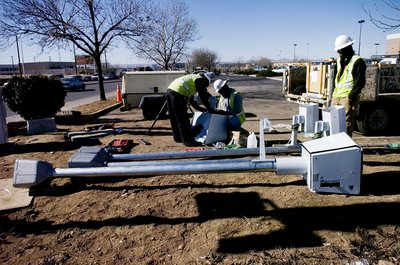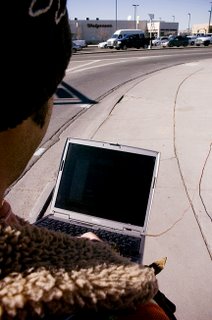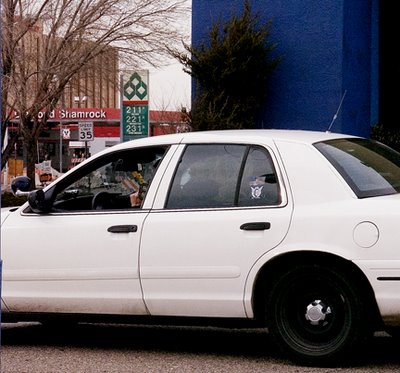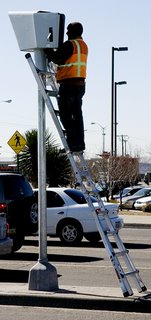 This is a group of workers from Bixby Electric Inc., contracted by the city to install red light cameras and speed-detecting devices, euphemistically called automated enforcement, assembling two units at Carlisle and Menaul Boulevards Jan. 15.
This is a group of workers from Bixby Electric Inc., contracted by the city to install red light cameras and speed-detecting devices, euphemistically called automated enforcement, assembling two units at Carlisle and Menaul Boulevards Jan. 15.“Don’t take my picture Bro,” one of the workers said. When someone working for the government makes such a request of me, the next sound heard is the result of a depressed shutter release. However, I did not shoot in a way that the worker can be identified. I am not interested in who the worker is, but what the worker is doing.
 This is the resident Redflex Traffic Systems maintenance/repair worker troubleshooting the SMARTCAM® digital imaging system at North Coors Road and Central Avenue. The flash unit was not working and he was going to order a replacement.
This is the resident Redflex Traffic Systems maintenance/repair worker troubleshooting the SMARTCAM® digital imaging system at North Coors Road and Central Avenue. The flash unit was not working and he was going to order a replacement. Redflex is the Scottsdale, Ariz. based contractor that provides, installs, maintains, gathers and processes visual evidence and issues notices of violations, then takes a share of the fines generated by their equipment.
I asked him for his name. He readily gave me his first name, but balked at giving his last name. “I don’t want people to know I’m the guy working on these (cameras).”
Asked how well the system held up and if there were any maintenance problems, he said the equipment was working well, with little problems. “Except for the paint-ballers,” he went on to say. Over the Jan. 13-14 weekend, six cameras were attacked with paint balls and the following Tues. – Wed., 11 units had paint splattered on the glass faceplate.
“It’s job security,” the worker said of having to clean off the cameras of the water-soluble paintballs.
So what's wrong with this picture?
 Hiding in plain sight is Albuquerque Police Traffic Unit Officer Jack Coraci at Menaul Blvd. and Mesilla St., operating a laser radar unit from an unmarked police car. The motorists who are stopped by Coraci at least have the right to go to court and face their accuser.
Hiding in plain sight is Albuquerque Police Traffic Unit Officer Jack Coraci at Menaul Blvd. and Mesilla St., operating a laser radar unit from an unmarked police car. The motorists who are stopped by Coraci at least have the right to go to court and face their accuser. Accused violators are presumed innocent and entitled to have every element of the offense proven beyond a reasonable doubt before an independent magistrate who has to make a determination of guilt. The judge may then impose a wide range of sentencing options from: dismissing the case, granting a conditional discharge, taking the matter under advisement, a form of probation, suspending part or all of any fine, sentencing to community service or suspending part or all of any incarceration, or ultimately to sentence the individual to the maximum punishment allowed by law for the misdemeanor; $500 and 90 days in jail.
 There is something wrong when workers who are either installing or maintaining the automated enforcement equipment are hesitant to be identified with their employer’s product. I don’t actually know why the installer didn’t want his picture taken, but the maintenance/repair worker said it was because he didn’t want any hassle over what he does.
There is something wrong when workers who are either installing or maintaining the automated enforcement equipment are hesitant to be identified with their employer’s product. I don’t actually know why the installer didn’t want his picture taken, but the maintenance/repair worker said it was because he didn’t want any hassle over what he does. It seems that being associated with Big Brother isn’t such a popular gig. I’ve illustrated the actions while respecting their identity. I do not support violence or vandalism; nor do I support violation of speeding or ignoring red lights.
At the same time, I do not support government that uses a civil theory and “automated enforcement” to substitute for good misdemeanor law – the state’s motor vehicle code and city’s traffic ordinance - to trigger an offense of the Safe Traffic Operations Program ordinance.
There is something fundamentally wrong when a person working for the “public good’ either outright fears, or is leery of being identified with this dreaded machinery. It’s not necessary for law to be popular, but when they seem overreaching and unfair, those who propagate them might wish too rethink them. The automated enforcement looks like a toll-road for a “self-selected” few. The STOP has all the popularity that George III, King of England’s Stamp Tax had in the mid 1770s.
No comments:
Post a Comment